
The Bell UH-1 Iroquois is a utility military helicopter designed and produced by the American aerospace company Bell Helicopter. It is the first member of the prolific Huey family, as well as the first turbine-powered helicopter in service with the United States military.
Operation Jefferson Glenn ran from 5 September 1970 to 8 October 1971 and was the last major operation in which U.S. ground forces participated during the Vietnam War and the final major offensive in which the 101st Airborne Division fought. This was a joint military operation combining forces of the 101st Airborne and the Army of the Republic of Vietnam (ARVN) 1st Infantry Division.

Marine Light Attack Helicopter Squadron 367 (HMLA-367) is a United States Marine Corps helicopter squadron consisting of AH-1Z Viper attack helicopters and UH-1Y Venom utility helicopters. Originally commissioned during World War II, the squadron participated in combat operations on Peleliu and Okinawa. Reactivated during the Vietnam War, the squadron has served during numerous conflicts since. The squadron is based at Marine Corps Air Station Camp Pendleton, California and falls under the command of Marine Aircraft Group 39 (MAG-39) and the 3rd Marine Aircraft Wing.

Marine Light Attack Helicopter Squadron 369 (HMLA-369) is a United States Marine Corps helicopter squadron consisting of AH-1Z Viper attack helicopters and UH-1Y Venom utility helicopters. The squadron, also known as the "Gunfighters", is based at Marine Corps Air Station Camp Pendleton, California and falls under the command of Marine Aircraft Group 39 (MAG-39) and the 3rd Marine Aircraft Wing.

A carrier air wing is an operational naval aviation organization composed of several aircraft squadrons and detachments of various types of fixed-wing and rotary-wing aircraft. Organized, equipped and trained to conduct modern US Navy carrier air operations while embarked aboard aircraft carriers, the various squadrons in an air wing have different but complementary missions, and provide most of the striking power and electronic warfare capabilities of a carrier battle group (CVBG). While the CVBG term is still used by other nations, the CVBG in US parlance is now known as a carrier strike group (CSG).

Naval Air Station Cecil Field or NAS Cecil Field was a United States Navy air base, located in Duval County, Florida. Prior to October 1999, NAS Cecil Field was the largest military base in terms of acreage in the Jacksonville, Florida area.

USS Garrett County (LST-786) was an LST-542-class tank landing ship built for the United States Navy during World War II. Named after Garrett County, Maryland, she was the only U.S. Naval vessel to bear the name.
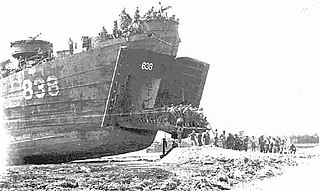
USS Hunterdon County (LST-838) was an LST-542-class tank landing ship built for the United States Navy during World War II, and later reconfigured and recommissioned for riverine warfare during the Vietnam War. Named after Hunterdon County, New Jersey, she was the only U.S. Naval vessel to bear the name.

Helicopter Sea Combat Squadron 84 (HSC-84) "Red Wolves" was a helicopter squadron of the United States Navy Reserve. Along with the "Firehawks" of HSC-85, the “Red Wolves” were one of only two squadrons in the U.S. Navy dedicated to supporting Navy SEAL and SWCC Teams, and Combat Search & Rescue. Prior to their deactivation in March 2016 they operated 14 HH-60H Rescue Hawks organized into four independent, two aircraft detachments that could deploy anywhere in the world within 72 hours of notice.
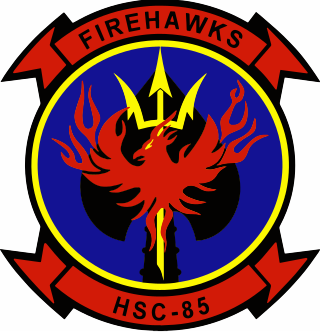
Helicopter Sea Combat Squadron EIGHT FIVE (HSC-85) was a United States Navy Reserve forces helicopter squadron (RESFORON) based out of Naval Air Station North Island in San Diego, California. The "FIREHAWKS" of HSC-85 are Reserve and Active Component Sailors who operate and maintain Sikorsky MH-60S Seahawk helicopters.

The Experimental Military Unit (EMU) was a joint Australian-American company-sized helicopter assault force which operated during the Vietnam War. The unit was created in 1967 following a request from the United States military for Australia to send more helicopter pilots to the conflict. As the only available personnel were from the Royal Australian Navy (RAN) Fleet Air Arm, the RAN Helicopter Flight Vietnam (RANHFV) was formed and integrated into the 135th Assault Helicopter Company of the United States Army. The EMU unit name was selected by the Americans as a backronym for the Australian bird, a choice which amused the Australians: despite being large, fast, and highly mobile, the emu cannot fly.
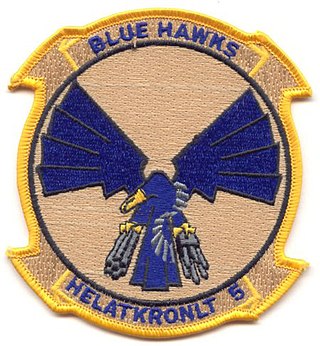
Helicopter Attack Squadron (Light) Five, known by the US Navy designation HA(L)-5, was the initial designation of a Naval Special Warfare and close air support helicopter squadron in the period following the Vietnam War, which, along with its sister squadron HA(L)-4 "Red Wolves", was one of the last two US Navy squadrons using HH-1K "Huey" gunships. In October 1989 the squadron was redesignated Helicopter Combat Support Squadron Special Five (HCS-5), it adopted the name "Firehawks" and it traded in its "Hueys" for HH-60H Seahawk Combat Search and Rescue helicopters. The squadron was deactivated on 13 December 2006.
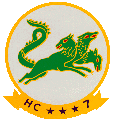
Helicopter Combat Support Squadron Seven (HC-7) was a helicopter squadron of the United States Navy established on 1 September 1967 and disestablished on 30 June 1975.

VA-164, nicknamed the Ghostriders, was an Attack Squadron of the U.S. Navy. It was established on 1 September 1960 and disestablished on 12 December 1975.

Helicopter Sea Combat Squadron 2 , also known as the "Fleet Angels", is a helicopter squadron of the United States Navy based at Naval Station Norfolk operating the Sikorsky MH-60S Seahawk. The Fleet Angels are a Fleet Replacement Squadron providing trained MH-60S crew to units on the East Coast.
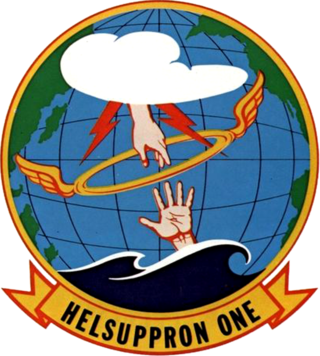
Helicopter Combat Support Squadron 1 (HC-1) was a helicopter squadron of the United States Navy operating several helicopter types in support of United States Pacific Fleet ships and other units. The squadron was established on 1 April 1948 and disestablished on 29 April 1994. It was nicknamed "Pacific Fleet Angels" or just "Angels".
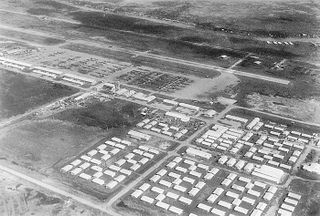
Binh Thuy Air Base was a United States Air Force (USAF), United States Navy, Republic of Vietnam Air Force (RVNAF) and Vietnam People's Air Force (VPAF) (Khong Quan Nhan Dan Viet Nam) military airfield used during the Vietnam War. It is located 7 km northwest of Cần Thơ in the Mekong Delta.

Operation Shufly was a United States Marine Corps operation to improve the mobility of Army of the Republic of Vietnam (ARVN) forces in the early phases of the Vietnam War from 1962 to 1965. Beginning on 15 April 1962, Marine helicopter squadrons, associated maintenance units and air traffic control detachments deployed to Sóc Trăng Airfield in the Mekong Delta and later to Da Nang Air Base rotating every four months in order to provide assault support and CASEVAC assistance during combat operations. By early 1965 half of the Marine Corps' medium helicopter squadrons had rotated through a "Shufly" deployment. The operation ended on 8 March 1965, when the 9th Marine Expeditionary Brigade came ashore in Vietnam as the vanguard of the United States' commitment of large numbers of regular combat units into South Vietnam.



















